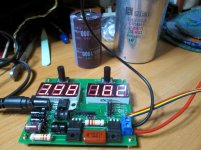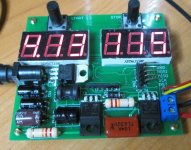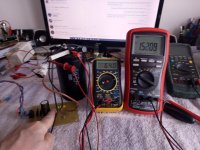84 volt will give you 117v dc, a tad to much, if you own a vario transformer that would make things easy
My father was used to connecting the capacitor to reform to a bulb in series towards a power supply 1/4 or less its maximum voltage overnight. On the second night the voltage was increased to 1/2 and on the third night rise the voltage again to 90% of its maximum voltage. With old capacitors (1960s) this method never failed.
I have a 100K 2W Lin. pot Bourns 3590S-1-104L, could I use between txs to lower the output voltage?84 volt will give you 117v dc, a tad to much, if you own a vario transformer that would make things easy
Power amps or cap rated?Simply connect it at nominal voltage thru a resistor.
If money is no object 🙂, invest in one (or 2) of these: https://vi.aliexpress.com/item/1005..._main.144.21ef1802RPzpPP&gatewayAdapt=glo2vnm
Use the @marigno idea and you will be OK. Not the power amp, a separated power supply and at the end check the leakage current (at a voltage from the final usage).
The main purpose for which the reforming is done is to reduce the initial leakage current and to not destroy the capacitor due to the weakened/damaged insulating layer.
Reformation restores this layer.
After the layer has been at least partially redone but enough to not lead to the failure of the capacitor, the reformation can be continued in the final PCB/diagram.
The aliexpress module maybe work but is not needed, can be done manually without any problems.
The main purpose for which the reforming is done is to reduce the initial leakage current and to not destroy the capacitor due to the weakened/damaged insulating layer.
Reformation restores this layer.
After the layer has been at least partially redone but enough to not lead to the failure of the capacitor, the reformation can be continued in the final PCB/diagram.
The aliexpress module maybe work but is not needed, can be done manually without any problems.
I don't have light bulbs.Use the @marigno idea and you will be OK. Not the power amp, a separated power supply and at the end check the leakage current (at a voltage from the final usage).
The main purpose for which the reforming is done is to reduce the initial leakage current and to not destroy the capacitor due to the weakened/damaged insulating layer.
Reformation restores this layer.
After the layer has been at least partially redone but enough to not lead to the failure of the capacitor, the reformation can be continued in the final PCB/diagram.
The aliexpress module maybe work but is not needed, can be done manually without any problems.
Assume you have a 50Vdc supply, a 50K resistor in series with the cap will limit the current to 1mA max.
The voltage across the cap will slowly rise to a bit less than 50V. The voltage across the resistor will give you the leakage current i = Vr/50K.
The voltage across the cap will slowly rise to a bit less than 50V. The voltage across the resistor will give you the leakage current i = Vr/50K.
To format the capacitors, I made a device in which the voltage can be adjusted from 0 to 450V. Formatting the capacitor is carried out automatically, the charge current does not exceed 4mA. After the end of the formatting, the device discharges the capacitor.
Attachments
I don't have light bulbs.
Ay coño! No tienes ni una bombilla?
Don't waste you're time trying to reform capacitors that have already expired. Once the electrolyte has dried out, there is absolutely NO proper way to rejuvenate them. The General Radio (Genrad) GR1617 is one of the few widely used instruments qualified to determine a capacitors performance for mil spec parts. Most of these testers are no longer capable of proper validation of new parts due to deterioration of the 1687's polystyrene reference cap. This may skew the results during QA of current parts offered for sale today.
Vivo en el primer mundo, todo LEDs, hay que joderse....Ay coño! No tienes ni una bombilla?
New caps 400-500€, I'm old and I don't work, first to spend the money I can waste my time.Don't waste you're time trying to reform capacitors that have already expired. Once the electrolyte has dried out, there is absolutely NO proper way to rejuvenate them. The General Radio (Genrad) GR1617 is one of the few widely used instruments qualified to determine a capacitors performance for mil spec parts. Most of these testers are no longer capable of proper validation of new parts due to deterioration of the 1687's polystyrene reference cap. This may skew the results during QA of current parts offered for sale today.
IMO, it depends on the capacitor. For small and medium value capacitors that are easily replaced, I agree that there is no value in trying to reform them - they are very susceptible to drying out over time. For large value, bulk filter type capacitors - typically with screw terminal attachments - such as Sprague's 36D series and similar, reforming typically is either not needed at all or is usually successful if it is required.Don't waste you're time trying to reform capacitors that have already expired. Once the electrolyte has dried out, there is absolutely NO proper way to rejuvenate them. The General Radio (Genrad) GR1617 is one of the few widely used instruments qualified to determine a capacitors performance for mil spec parts. Most of these testers are no longer capable of proper validation of new parts due to deterioration of the 1687's polystyrene reference cap. This may skew the results during QA of current parts offered for sale today.
The main thing to do in order to successfully reform a capacitor without damaging it is to limit the charging current to no more than a couple of milliamps at most. As has been mentioned, by far the easiest way to do this is to use a 1K resistor in series with one of the charging leads. As the reforming voltage should be incremented in steps - I use 25/50/75/100 percent - this will limit the current even for higher voltages. The 1K makes an easy way to monitor the leakage current once at full voltage - check the datasheet for the DUT to see the allowable range.
Hal
- Home
- Design & Build
- Parts
- Reforming electrolytic capacitors





